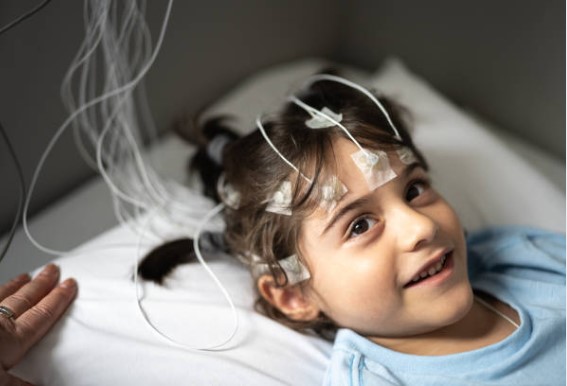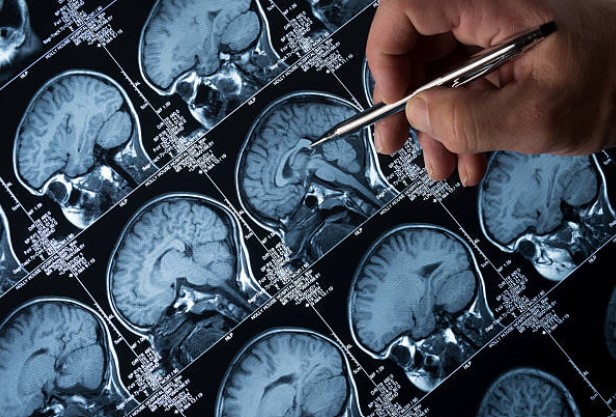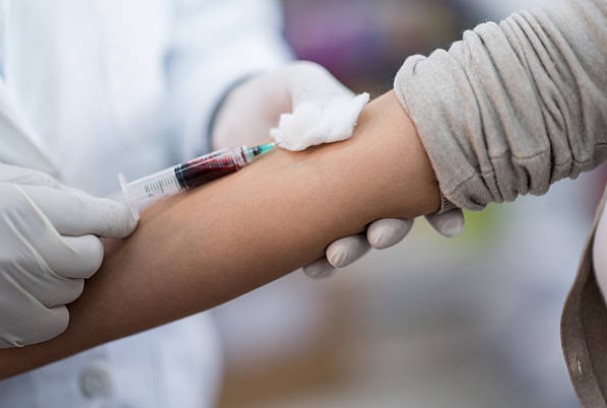Contact Us
- +91-7696675086
- neharai2012@gmail.com
- Livasa Hospital, Chandigarh Road, Hoshiarpur, Punjab 146001

Overview of Epilepsy
Epilepsy is a neurological disorder where nerve cells in the brain work in an abnormal way resulting in recurrent and unprovoked seizures. A seizure is an uncontrolled outcome of electrical activities that develop sensations, affect the movement of the person, and also affect consciousness.
Epilepsy is also known as a seizure disorder. Anyone at any age or any sex can experience seizure disorder or epilepsy.
Types of epilepsy and symptoms of epilepsy
There are several types of epilepsy, typically classified based on the type of seizure and its origin in the brain. Here are the main types:
Focal onset seizures:
Focal onset seizures begin in one location of cells in the brain or one side of the brain. This is known as a Partial onset seizure. There are two types of focal seizures.
Focal Onset aware seizures :
In this type of seizure, a person faces seizure when the person is awake. It is also known as a simple partial seizure.
Common Symptoms of Focal Aware Seizures or Focal Simple Partial Seizure.
🔹 Motor Symptoms:
Jerking or twitching in one part of the body (e.g., hand, arm, face)
Muscle stiffness or weakness
Repetitive movements (e.g., lip-smacking, hand rubbing)
🔹 Sensory Symptoms
Tingling, numbness, or “pins and needles”
Visual disturbances (flashes of light, distortions)
Auditory hallucinations (buzzing, ringing)
Unusual smells or tastes
Feeling of heat or cold
🔹 Autonomic Symptoms
Changes in heart rate
Sweating
Goosebumps
Nausea or abdominal discomfort
🔹 Psychic Symptoms
feeling something is strangely familiar or unfamiliar
Sudden fear, anxiety, or euphoria
Distorted perception of time or reality
These seizures are typically brief, lasting seconds to a couple of minutes, and may serve as a warning (aura) before a more severe seizure.
Focal onset impaired awareness:
Focal Onset Impaired Awareness Seizures (previously called complex partial seizures) begin in one part of the brain (focal onset) and involve altered or impaired consciousness or awareness during the seizure. The person may appear awake but is not fully responsive or aware of their surroundings.
Common Symptoms of Focal Onset Impaired Awareness Seizures:
🔹 Impaired Awareness
Blank staring or unresponsiveness
Confusion during or after the seizure
No memory of the event afterward
🔹 Automatisms (Involuntary Movements)
Lip smacking
Chewing or swallowing
Picking at clothes or objects
Repetitive hand or finger movements
Wandering or walking aimlessly
🔹 Behavioral Changes
Sudden emotional outbursts (fear, anger, laughter)
Inappropriate responses or speech
Repeating words or phrases (if speech is possible)
🔹 Aura (Warning Symptoms) Beforehand
Some individuals may experience a focal aware seizure (aura) immediately before the impaired awareness sets in. These could include:
Strange smells, tastes, or sensations
Visual disturbances
Rising feeling in the stomach
Sudden fear
Duration and Recovery: Typically lasts 1–2 minutes
Recovery may involve confusion, fatigue, or disorientation (postictal phase)
Generalized onset Seizures:
This type seizures affect a wide aspect network of cells of both sides of the brain at same time.
There are six types of generalized seizures.
1) Absence seizures:
Absence seizures (formerly called petit mal seizures) are a type of generalized seizure that involves a brief, sudden lapse in consciousness. They are most common in children & adults. In this type of seizure, the affected person stares into space or blank stares.
Key Features of Absence Seizures:
Sudden Loss of Awareness
The person appears to “zone out” or stare blankly into space.
They do not respond when spoken to or touched.
Brief Duration
Typically lasts 5 to 15 seconds, rarely more than 30 seconds.
Can happen many times a day.
Automatisms (Subtle Movements)
Eye blinking
Lip smacking
Chewing motions
Small hand movements
No Postictal Confusion
Unlike other types of seizures, the person quickly returns to normal afterward, with no confusion or memory of the event.
2) Atonic seizures:
This is also called drop attacks. It is a type of generalized seizure where the person experiences a sudden and brief loss of muscle tone. This can cause them to collapse, fall, or drop their head or limbs unexpectedly.
Key Features of Atonic Seizures:
- Sudden Loss of Muscle Tone
- May affect the whole body or just certain muscles (e.g., neck, legs).
Can cause:
- Sudden collapse or fall to the ground
- Head nodding or jaw dropping
- Dropping of objects from the hands
Very Brief Duration
- Usually lasts less than 15 seconds.
- Person typically recovers quickly, but may be confused or dazed briefly.
High Risk of Injury
- Because of the sudden fall, there’s a risk of head injuries or bruises.
- Helmets may be recommended in severe cases for safety.
Awareness
Varies: some remain conscious, others may briefly lose awareness.
Common Causes or Associations:
- Often seen in epilepsy syndromes like Lennox-Gastaut syndrome.
- Typically resistant to treatment and may require medications, diet therapy (like ketogenic diet), or vagus nerve stimulation (VNS).
3) Tonic seizures:
It is type of generalized seizure characterized by a sudden stiffening (increased muscle tone) in the muscles, often affecting the arms, legs, or entire body. They usually last less than 20 seconds and can occur during sleep or while awake.
Key Features of Tonic Seizures:
Muscle Stiffness
Sudden, sustained muscle contractions cause the body or limbs to stiffen and become rigid.
Often affects the back, arms, and legs. May cause the person to fall backward if standing (unlike atonic seizures, where they collapse forward or go limp).
Short Duration
- Typically lasts 10 to 20 seconds.
- Recovery is usually quick, but the person may be confused or tired afterward.
Awareness
- Can occur with or without loss of consciousness.
- If consciousness is impaired, the person may not remember the event.
Common During Sleep
Tonic seizures are often nocturnal, which can make them harder to recognize.
Associated Conditions:
Common in certain epilepsy syndromes, especially Lennox-Gastaut syndrome.
Often seen in people with developmental or neurological disorders.
Risks and Complications:
Falls or injuries due to sudden muscle stiffening, especially if standing or walking at onset.
May require protective measures like helmets if frequent and severe.
4) Clonic seizures:
It is a type of generalized seizure characterized by repetitive, rhythmic jerking movements of the muscles. These movements typically affect both sides of the body and are caused by repeated contraction and relaxation of muscles.
Key Features of Clonic Seizures:
🔹 Rhythmic Jerking Movements
- Repetitive muscle contractions and relaxations.
- Usually affects the arms, neck, and face, but can involve other parts of the body.
🔹 Moderate Duration
- Typically last a few seconds to a minute.
- Less common than tonic-clonic seizures.
🔹 Awareness
- Loss of consciousness is common, but not always present.
- The person may be confused or drowsy after the seizure (postictal phase).
Clonic vs. Tonic-Clonic Seizures
Clonic seizures involve only the jerking phase.
Tonic-clonic seizures have a tonic phase (stiffening) followed by a clonic phase (jerking).
Who Gets Clonic Seizures?
More common in infants and young children, but can occur at any age.
May be part of certain epilepsy syndromes or occur after brain injury, infection, or metabolic issues.
5) Tonic-clonic seizures:
It is formerly known as grand mal seizures) are the most well-known and dramatic type of generalized seizure, involving both muscle stiffening (tonic phase) and rhythmic jerking (clonic phase). They affect the entire brain and typically result in loss of consciousness.
Phases of a Tonic-Clonic Seizure:
1. Tonic Phase (10–20 seconds):
- Sudden loss of consciousness .
- Body stiffens, often causing the person to fall if standing.
- Possible cry or grunt as air is forced out of the lungs.
- May stop breathing briefly, resulting in a bluish face or lips.
2. Clonic Phase (30–60 seconds):
- Rhythmic jerking of the limbs and face
- Possible tongue biting or incontinence
- Breathing usually resumes but may be irregular
3. Postictal Phase (minutes to hours):
- Deep sleep or confusion
- Headache, fatigue, or soreness
- No memory of the seizure
Key Characteristics:
- Involves the entire body.
- Often triggered by missed medications, sleep deprivation, flashing lights (in photosensitive epilepsy), or stress.
Can be dangerous due to the risk of falls or injury.
Medical Considerations:
Emergency help is needed if the seizure lasts longer than 5 minutes, if it’s the person’s first seizure, or if they don’t regain consciousness afterward.
6) Myoclonic seizures :
Myo means muscle and clonus means muscle jerking. Myoclonic seizures are a type of generalized seizure that involve sudden, brief, shock-like muscle jerks. These jerks are typically rapid and may affect the arms, legs, shoulders, or entire body. Unlike other seizure types, consciousness is usually not impaired.
Key Features of Myoclonic Seizures:
Muscle Jerks
- Sudden, involuntary jerks of one or more muscle groups
- Often occur bilaterally (on both sides of the body)
- May be so subtle they look like a quick twitch or so strong they cause the person to drop something or fall.
Very Brief Duration
- Typically last less than 1–2 seconds
- May occur once or in clusters over several minutes
Awareness
- Consciousness is usually preserved, though the person may be startled or surprised
- No postictal confusion (no recovery phase is typically needed)
Common Times of Occurrence
- Frequently happen soon after waking up.
- Often triggered by fatigue, stress, or flashing lights.
Associated Conditions
- Frequently seen in Juvenile Myoclonic Epilepsy (JME).
- Can also occur in progressive myoclonic epilepsies, which are rare and often more severe.
General Signs and Symptoms of Seizures:
Seizure signs and symptoms can vary widely depending on the type of seizure, where it originates in the brain, and whether it involves altered awareness or movement. Below is a general overview of common signs and symptoms of seizures:
Genetic Causes
- Family history of epilepsy
- Inherited genetic mutations (can cause epilepsy directly)
- Certain epilepsy syndromes (e.g., Juvenile Myoclonic Epilepsy, Dravet Syndrome)
Structural Causes
- Scar tissue in the brain (gliosis)
- Stroke (especially in older adults)
- Traumatic brain injury (TBI)
- Brain infections causing structural damage
- Brain malformations (congenital or developmental)
Metabolic and Infectious Causes
- Autoimmune conditions affecting the brain
- Prenatal injuries (e.g., oxygen deficiency during birth)
- Infections like meningitis, encephalitis, neurocysticercosis
- Metabolic disorders (e.g., low blood sugar, electrolyte imbalance)
Immune-Related Causes
- Autoimmune encephalitis
- Neuroinflammatory conditions
Unknown Causes
- In about 50% of cases, no specific cause is identified (idiopathic epilepsy)
- May still be due to genetic or subtle structural causes not detectable with current imaging or testing
Age-Related Trends
- Adults: Head trauma, brain tumors
- Elderly: Stroke, Alzheimer’s disease, brain atrophy
- Infants and children: Birth injuries, genetic conditions, congenital brain malformations
Diagnosis and Tests for Epilepsy
Diagnosing epilepsy involves a combination of clinical evaluation, neurological testing, and brain imaging to confirm the presence of seizures and rule out other conditions. Here’s a breakdown of the key steps and tests used:
1. Medical History and Symptom Review

- Detailed description of the seizures:
- What happened before, during, and after?
- How long did they last?
- Any known triggers?
- Family history of epilepsy or neurological disorders
- Past medical events (e.g., head injury, infections, stroke)
2. Neurological Examination and Review

- Tests of reflexes, coordination, muscle strength, and sensory function
- Cognitive assessment (memory, attention, language)
3. Diagnostic Tests
a. Electroencephalogram (EEG)

Primary test for epilepsy
- Measures electrical activity in the brain.
- Video EEG monitoring is often used in hospitals to capture seizures as they happen
- Can detect abnormal patterns (e.g., spikes or sharp waves)
May be done during: - Wakefulness
- Sleep
- Seizure provocation (e.g., flashing lights, hyperventilation)
- Wakefulness
b. Brain Imaging

Brain Imaging
- MRI (Magnetic Resonance Imaging):
- Detects structural abnormalities like tumors, scar tissue, or brain malformations
- Detects structural abnormalities like tumors, scar tissue, or brain malformations
- CT Scan (Computed Tomography):
- Often used in emergencies or to detect bleeding or trauma
- Often used in emergencies or to detect bleeding or trauma
- PET or SPECT scans (in some cases):
- Show brain function and blood flow
- Show brain function and blood flow
Useful in epilepsy surgery planning
c. Blood Tests

- Rule out metabolic or infectious causes
- Check for genetic or autoimmune conditions
d. Genetic Testing

- If a hereditary epilepsy syndrome is suspected
- More common in pediatric epilepsy
e. Neuropsychological Testing
- Assesses brain function (memory, language, problem-solving)
- Helps identify areas of dysfunction and plan for surgery if needed
Health Tips & Info
Medicate is a long established fact that a reader will be distracted by the readable content of a page when looking at its layout.Lorem Ipsum is simply dummy text of the printing and typesetting industry.
Where Can I Go To Provide A Sample For Testing?
Lorem ipsum dolor sit amet, consectetur adipiscing elit. Ut elit tellus, luctus nec ullamcorper mattis, pulvinar dapibus leo.
What happens to my sample once I have provided it?
Lorem ipsum dolor sit amet, consectetur adipiscing elit. Ut elit tellus, luctus nec ullamcorper mattis, pulvinar dapibus leo.
What will laboratory testing cost me?
Lorem ipsum dolor sit amet, consectetur adipiscing elit. Ut elit tellus, luctus nec ullamcorper mattis, pulvinar dapibus leo.
Using Innovative Technology
Lorem ipsum dolor sit amet, consectetur adipiscing elit. Ut elit tellus, luctus nec ullamcorper mattis, pulvinar dapibus leo.